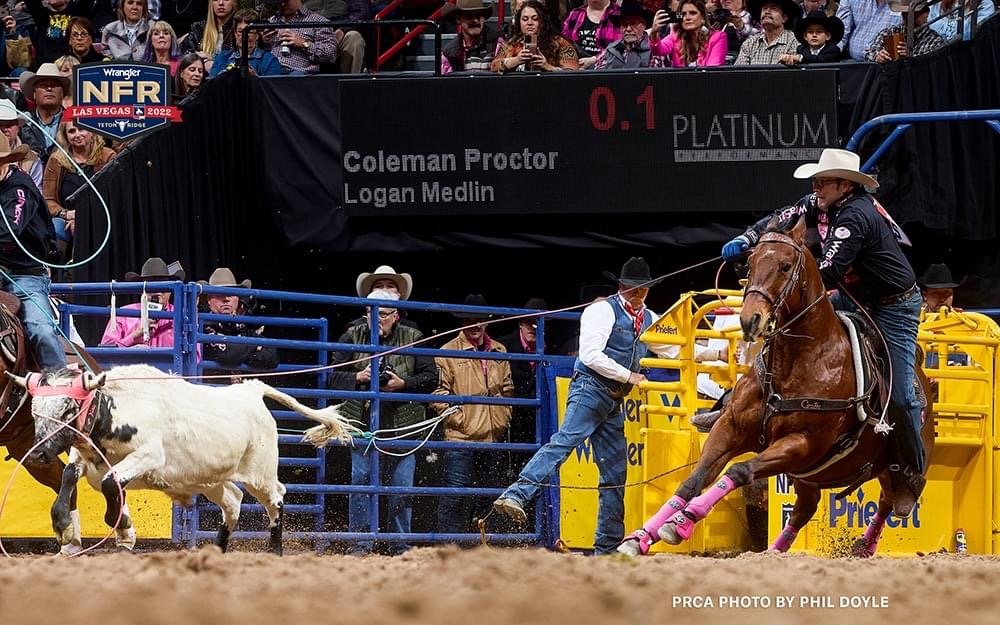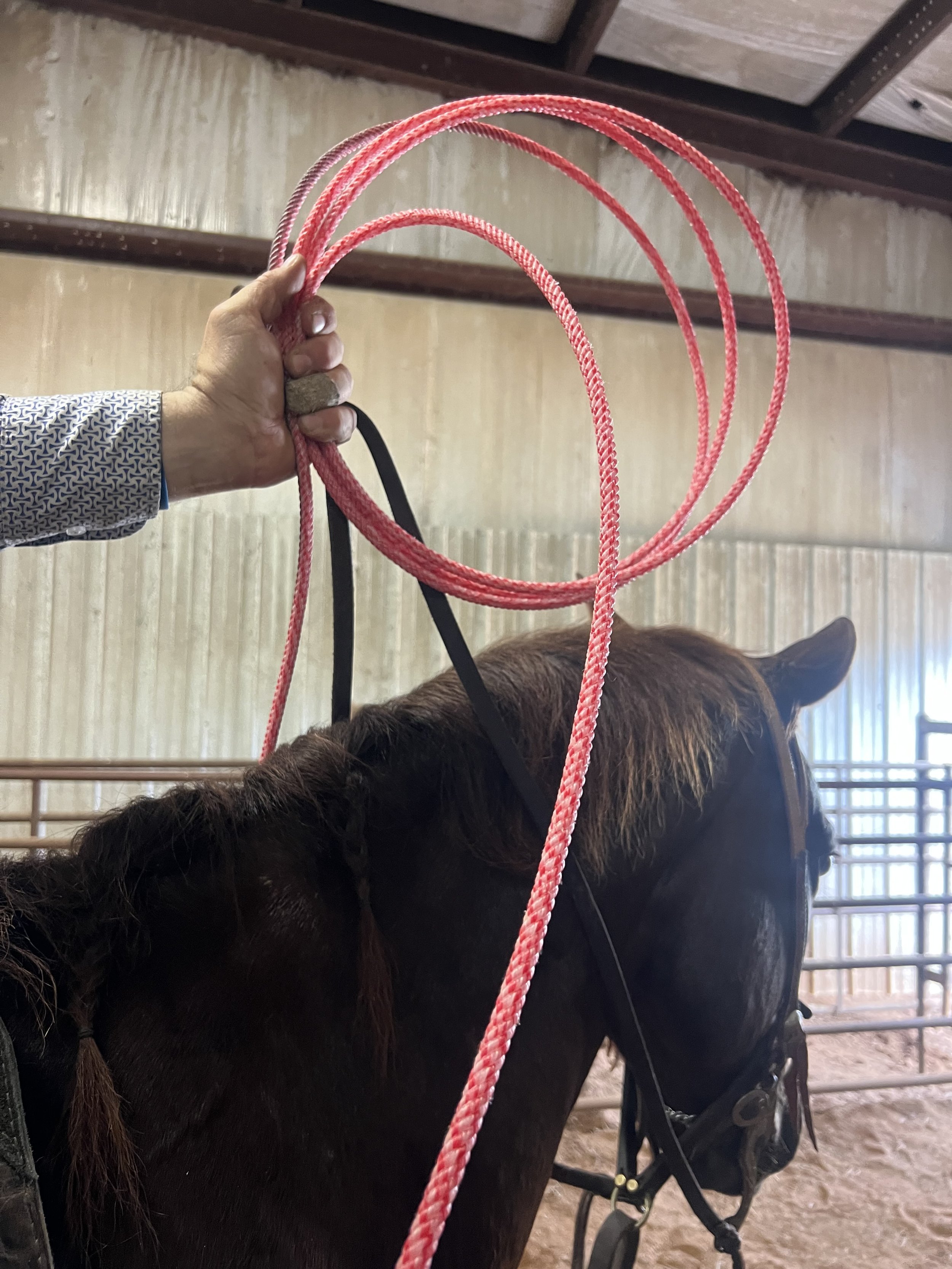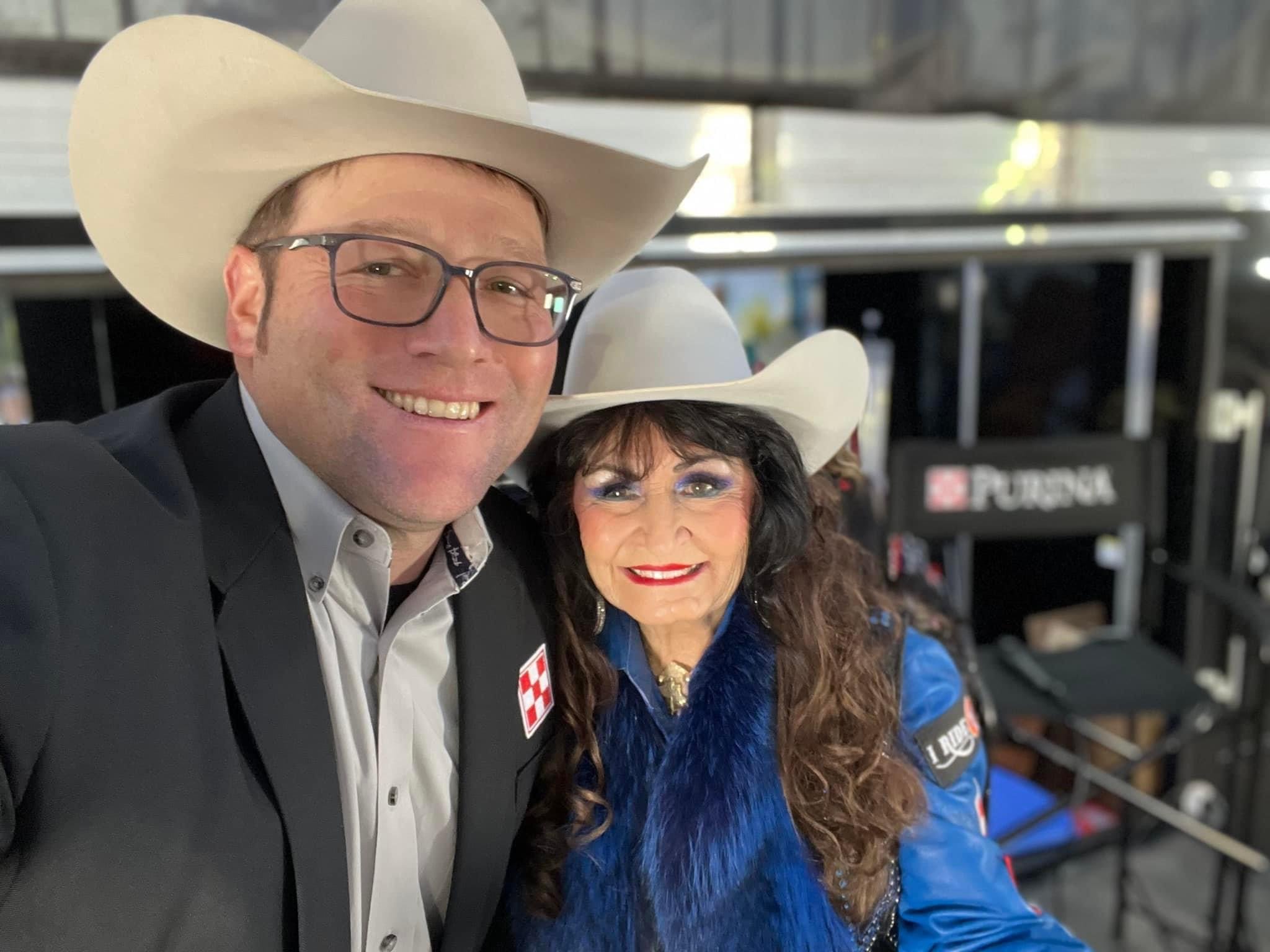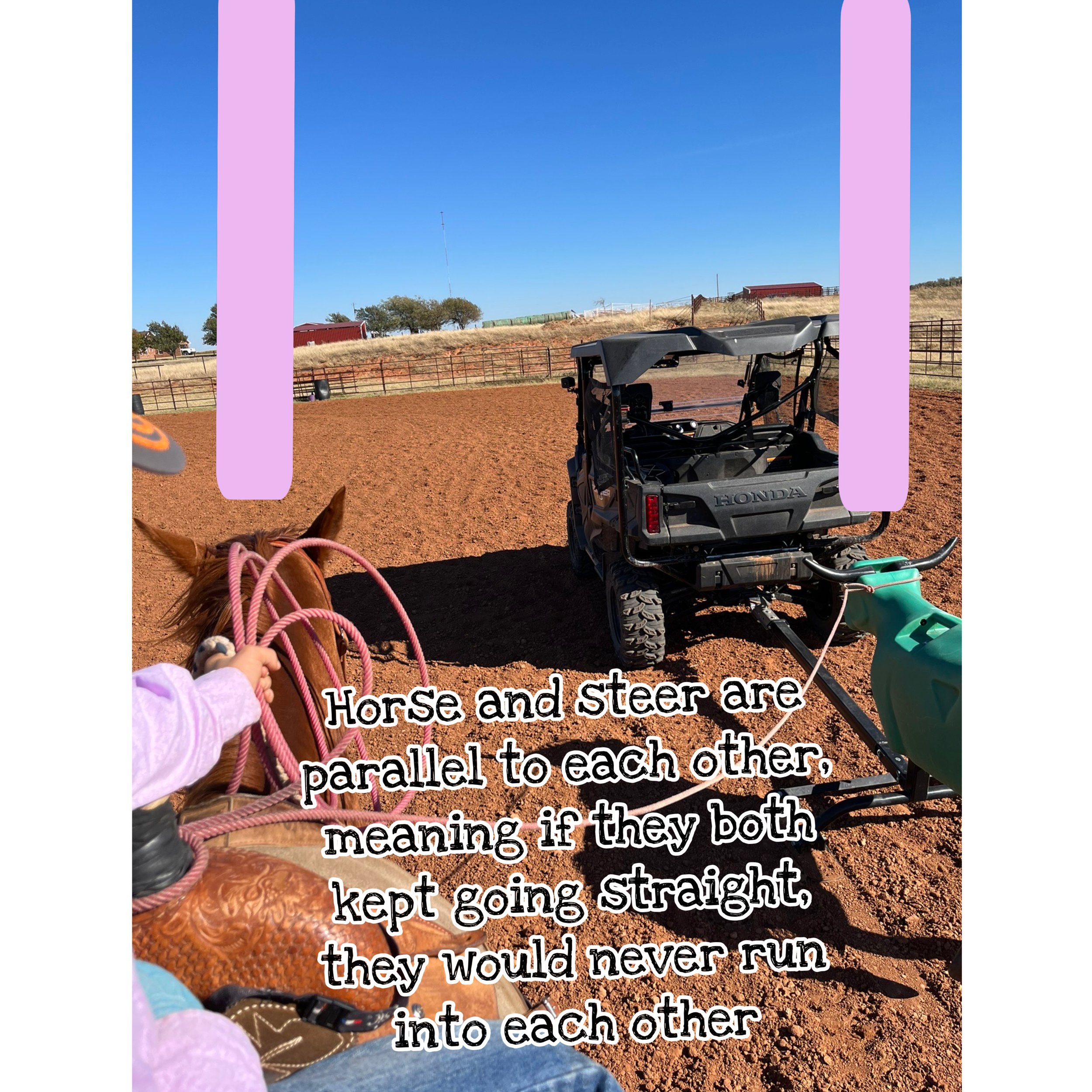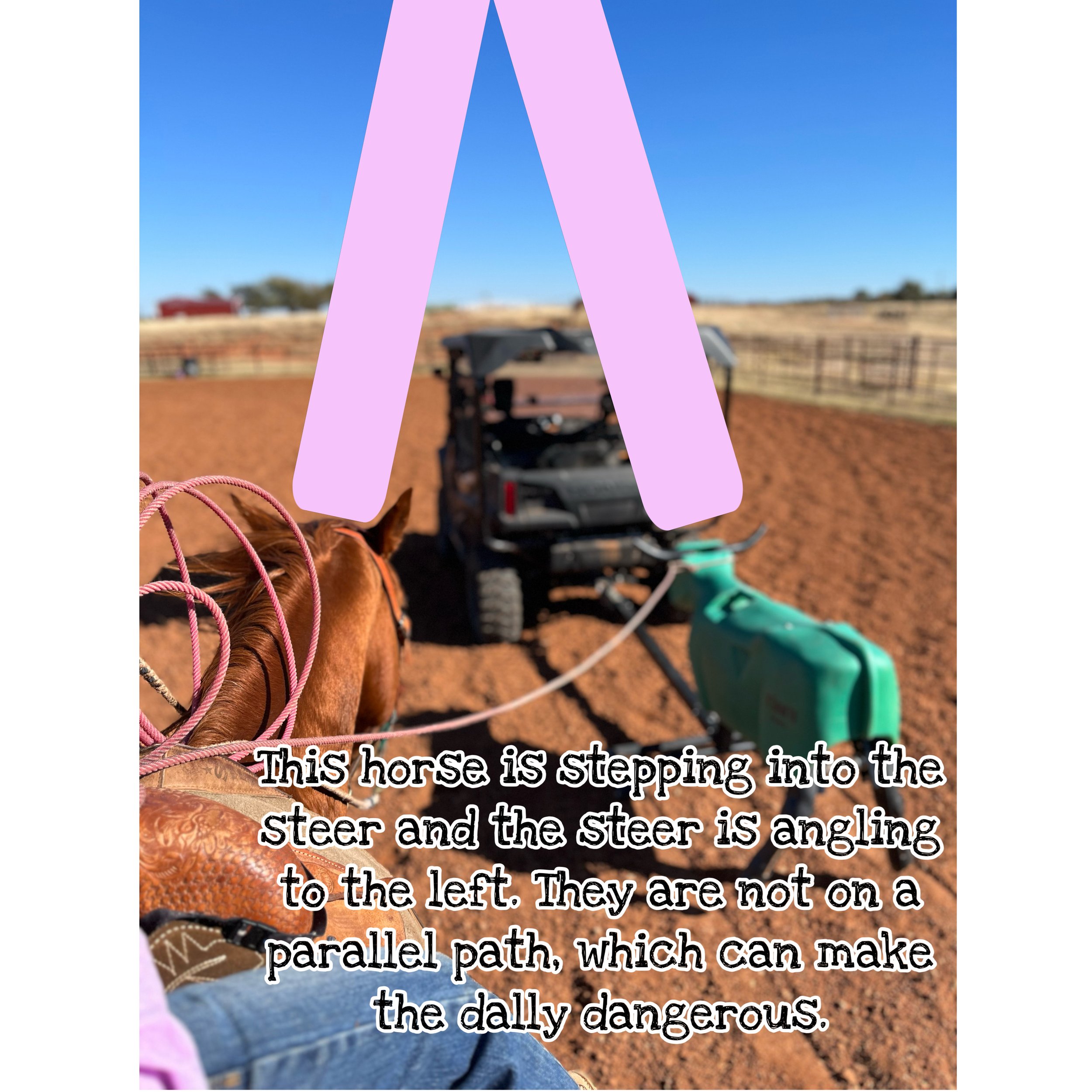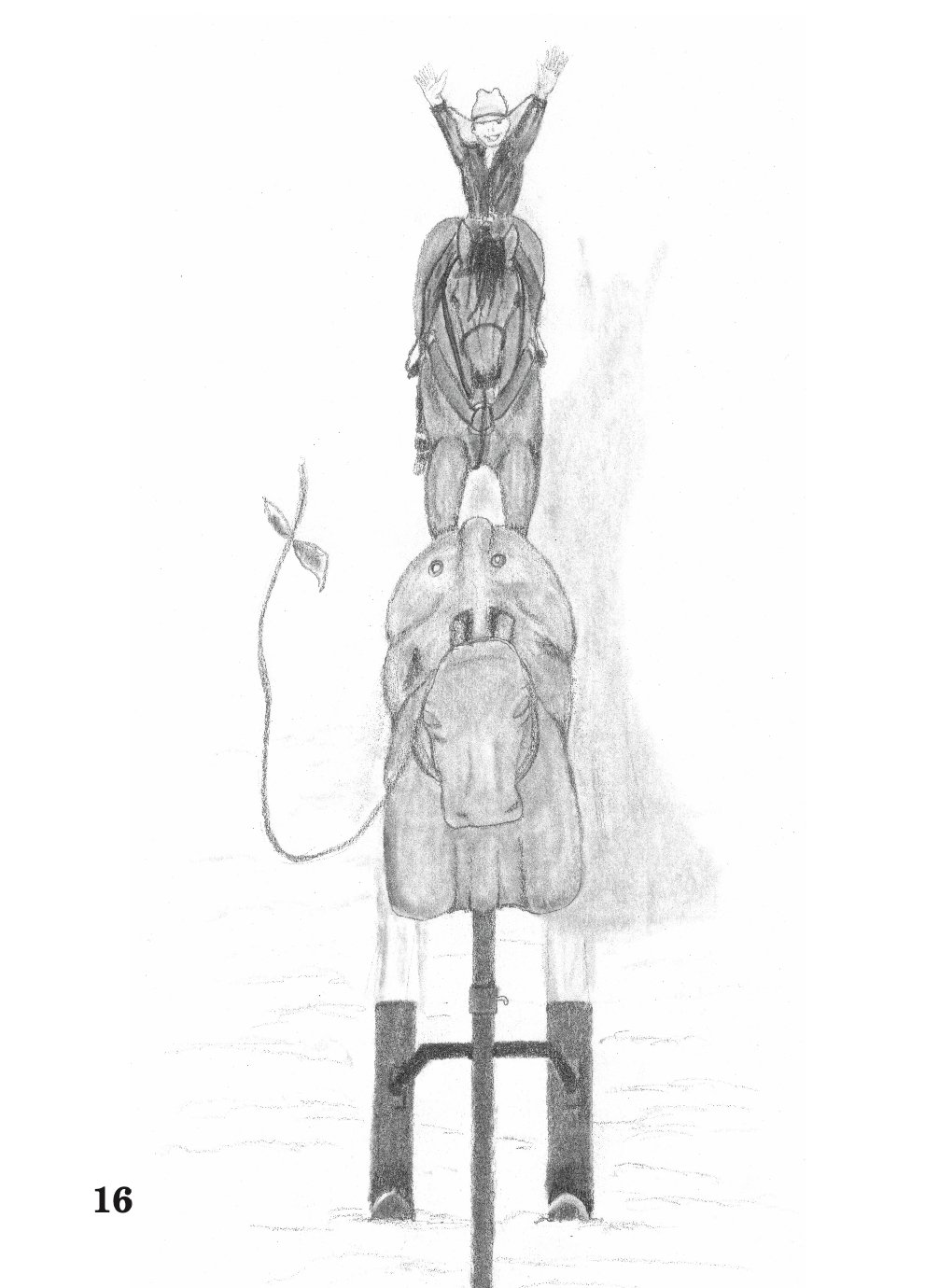Cowkids Only - November 2023
November 2023
Brought to you by The Bell Mare Book Company
Ask a Pro:
Coleman Proctor
Coleman Proctor is an 8-time National Finals Rodeo team roper and has won more than $1 million throughout his career. This photo was taken at the 2022 NFR. Coleman is riding his great horse, Heisman. Look at the clock on the scoreboard!
We caught up with Coleman while he was driving through the mountains on his way to a rodeo and he gave us some great advice for youth headers.
Ask a Pro:
NFR Header Coleman Proctor
Question: What tips do you have to help young headers dally safely?
Coleman’s Answer:
Keep your coils organized. I was super guilty of this when I was a kid too, but lots of kids don’t keep their coils organized in their left hand. When you don’t have your coils organized, it’s hard to let go of one single coil and not end up with a wad coming out of your hand and/or ending up with a coil around your wrist. When I say organized, I mean the coil closest to the tail of your rope should always be the biggest and your coil size should get smaller from there so your coil closest to your loop is the smallest.
You should roll your left wrist so your pinky is pointed toward your horse’s ears. I have noticed a lot of kids hold their coils with their thumb tilted forward and their pinky tilted towards their chest, so their coils don’t really get out of the way of their dally because the coils are hanging straight down. When you hold your reins and coils, rock your thumb back towards your chest and push your pinky towards your horse’s ears. That pushes your coils more towards your bridle and away from the saddle horn.
Push your left hand up your horse’s neck so you have room to dally, while still controlling your horse. A lot of kids tend to pull their left hand to the left of the horse’s neck to give themselves room to dally. But, that actually makes it harder because when you do that, you are telling your horse to go left and getting further away from the steer.
Question: What are some traits you think every youth heading horse should have?
Coleman’s Answer:
They need to be forgiving. If my daughters want to head when they get older, I am not going to look for something that is super fast or athletic for them to learn on. I want kids on a horse that is athletic enough to do their job, but not athletic enough to make any big or fast moves. They also need a very willing and honest attitude about their job.
I also like putting kids on horses that are older. My friend Martha Josey (a world champion barrel racer and excellent horsewoman), says the kid and horse’s combined age should be about 25. So if the kid is 10, the horse should be about 15. If the kid is 5, the horse should be 20. And, that isn’t just for kids. When I decided to start steer tripping, I bought a tripping horse that had the experience I didn’t, so we weren’t both trying to learn at the same time!
I want youth head horses to score well and be gentle in the box. I also want them to leave the box as smooth as possible. That is one area I think kids should all work on is staying with their horse as they leave the box. If your horse leaves the box flat and smooth, that will really help you develop the strength you need as a rider to stay with the momentum of your horse coming out of the box.
Question: What do you recommend youth headers work on in the practice pen?
Coleman’s Answer:
Work on getting your balance when you leave the box. Lots of kids rope the dummy on the ground very well, but then when they get on a horse, their roping falls apart because they start the run getting rocked back in their saddle as their horse leaves the box. You need to learn how to use your legs for balance as you leave the box and not your bridle reins. Once you figure out how to balance leaving the box, your first swing starts to have purpose. If you are balanced leaving the box, you can point your first swing at your target, instead of having to take four or five swings to get your loop going, bring your tip down and then get your aim right.
I also want kids to work on keeping their horse parallel to the cow after they catch so they can dally from a safe position. This teaches you to keep control of your horse throughout your run. If you can keep your horse parallel to the steer, meaning they don’t take a step left, right or slow down too much, while you dally, your transition across the pen is going to be a lot safer and better.
Steers that are slower and run straight down the pen are what I want kids to start out on. I also don’t want those steers to be big and heavy or drag because that’s a lot of momentum that kids aren’t really able to handle. As you progress, you can start to add in some steers that are a little more challenging, but only when you can maintain control of your horse on the easy steers. So much of being a successful roper is about being confident in yourself and your abilities, so you should rope cattle that are going to build up your confidence, not tear it down.
Question: What else do you want kids to know about roping?
Coleman’s Answer:
It’s OK to miss. Don’t get discouraged. At first, it is just about learning to catch. As you get better, start pushing yourself outside of your comfort zone a little. But don’t be afraid to fail because often times when we fail is when we learn the most. Just make sure as you step out of your comfort zone, keep maintaining your good basics - keep control of your horse, stay balanced leaving the box, keep a correct swing, etc.
Question: If you could get in a time machine and tell your younger self something, what would you say?
Coleman’s Answer:
Enjoy every step of your roping process. When you are a kid learning how to rope, that is the most fun you will ever have with a rope. Don’t rush out of that growing and learning phase. Being able to learn something new everyday and improve a little bit everyday is exciting, so if I could go back in time and tell myself something it would be to just enjoy the time I spent learning to rope.
Question: What is your favorite thing to read?
Coleman’s Answer:
I like reading books about strengthening my mental game. Like I said before, roping is all about being confident in yourself, so I like to read books that teach me how to stay positive and confident. When my wife talks me into spending time in beach sand instead of arena sand, I will read action novels by James Patterson.
Cowkid Devotional
By High Call Ministries Pastor, Kelly Cronkhite
Kelly is not your typical pastor. He’s a Jesus-loving cowboy, rancher and roper.
Do you love your horse? Do you know just where they like to be scratched? When they need a score? When they need a break? If you pay attention when you ride, you probably know your horse very well. But, do you know every single hair on his body? Of course not. No human is capable of knowing another being that well. But, guess what? God knows you so well that He knows every single hair on your head. He knows you and loves you more than anyone else ever could. His love for us runs so deep that He wants to be involved in every part of our life. Not just on Sunday morning at church. Don’t get me wrong, spending time with God at church is great, but that shouldn’t be where your friendship with God ends. Let Him be a part of your daily life too. You can say prayers - out loud or silent - to God at school, in the practice pen, at the rodeo, on the bus, etc. God knows every hair on your head and is never too busy to delight in the details of your life.
“The Lord would speak to Moses face-to-face, as one speaks to a friend.” - Exodus, Chapter 33, Verse 11
“The Lord directs the steps of the Godly. He delights in every detail of their lives.” - Psalms, Chapter 37, Verse 23
“And even the very hairs on your head are all numbered. So don’t be afraid.” - Matthew, Chapter 10, Verse 30-31
Joke Break!
What professional rodeo makes cowboys cry the most?
Keep reading to find the answer!
Horse Care Tip of the Month
By Equine Veterinarian Zach Bruggen
Have you ever heard the term, “oldie, but a goodie?” That phrase is so true when it comes to horses, especially junior rodeo horses. Even if you have been rodeoing your whole life, you still have probably been at it less than 10 years. Riding an older horse can help fill in the experience gap for you and make your job of learning to rope, barrel race, pole bend, goat tie, etc. easier. But, senior horses come with a special set of needs to keep them looking and performing their best. Here are a few recommendations I have for senior rodeo horses:
An annual lameness exam with a veterinarian, as well as additional visits as necessary. Senior horses might not ever be completely pain-free due to their age, but veterinarians have lots of tools that can help make them more comfortable and able to do their job.
An annual dental exam and float if necessary. Veterinarians use a special file, called a float, to keep horse’s teeth from getting sharp hooks and points that can make them uncomfortable and it difficult to properly chew their food. Senior horses are more likely to have dental issues than younger horses.
Annual bloodwork that checks for changes in organ function. Senior horses can be more likely to have diseases and we are better able to treat those if we catch them early. A simple blood test can tell us a lot about what is going on inside the horse’s body.
A joint supplement to help maintain daily joint health. There is evidence showing joint supplements with at least 10,000 milligrams of an ingredient called glucosamine can help keep joints healthier and supporting the horse for longer. Have your parents help you read the label on any joint supplement to make sure it has enough glucosamine in it to make a difference.
Adjust the horse’s nutrition as needed. As a horse ages, they might need to switch to a senior feed that is designed for older horses. These feeds are often easy to digest and chew and can help keep your senior horse looking and feeling their best. Also, if your senior horse is fed with other horses, you might consider separating them at feeding time to make sure they have enough time to eat all of their feed.
Senior horses can greatly benefit from a longer and slower-paced warm-up and a longer cool-down. Spending 15 minutes walking and slow trotting your senior horse before you ask them for any kind of performance will really help their muscles and joints prepare for what you are asking of them. After you practice or compete, spend 10-15 minutes walking your horse before you tie them to the trailer or put them away to help prevent sore muscles.
Senior Horse Care is Worth It!
With a little extra care, we can keep senior horses performing well into their 20s. Senior feed, regular veterinary care and a slower warm-up are just a few ways to keep your senior horse feeling their best. This pony’s name is Shorty and he is at least 25 years old. He eats senior feed and takes medicine daily for a disease called PPID, or Equine Cushing’s Disease, that is very common in older ponies.
Exercise of the Month
By Logan Corbett, with Champion Living Fitness and strength coach for many professional rodeo athletes
Have you ever seen a bird dog point? If you are a hunter, chances are you probably have. This month, we are going to learn how to do a “bird dog” exercise to improve our strength and balance. Much like last month’s “dead bug” exercise, the bird dog improves the strength of your stomach and back, also known as your “core,” muscles. Your core muscles are needed for every rodeo event from sheep riding and stick horse barrel racing to bull riding and roping. Bird dogs also help improve your posture, or the way you hold your body when you are standing. No matter what event you do, bird dogs are a great exercise for all rodeo athletes. They are especially helpful for:
Speed events that require great balance and stability in the saddle
Staying with your horse’s momentum as they leave the box in roping events and steer wrestling
Roughtstock events that require balance throughout an unpredictable and powerful ride
Staying balanced in the saddle as you swing your rope and ride your horse
Bird dogs should be done slowly so that you always have control of your body. By doing this exercise slowly, you will actually achieve greater benefits than doing it fast. This is because your muscles and brain are challenged more when they have to remain in control for an extended period of time. This is very similar to what we ask of our minds and bodies during a rodeo run or ride. The mind and body must work together to accomplish the challenge.
This exercise should be performed on carpet, a rug or an exercise mat so you don’t hurt your knees. To perform a bird dog, start on all fours. This is known as a table top position because your back should be flat like a table top. Put your knees directly under your hips and your hands directly under your shoulders. Tighten your stomach muscles to help provide stability for your back. Lift your right arm straight out in front of you, keeping it in line with your shoulder. At the same time, lift your left leg straight out behind you, keeping it in line with your hip. Hold your balance for a few seconds in this position. Keep your body in a straight line from your fingertips to your toes and keep your back flat. Then return to your starting position. Repeat the exercise on the other side, using your left arm and right leg (see video below for example). Try doing this six times on each side and then take a break. Repeat the exercise two to three more times every day to get the best results. Until next time, happy hunting!
Rodeo Word of the Month:
Hooey
This is the final knot in a boy’s goat tying or tie-down roping tie. Typically, three of the four legs on the goat or calf are wrapped twice and then secured with a type of knot called a hooey. This illustration is from our new chapter book, “Short Go and the Junior Rodeo Trail.” In this book for elementary-aged readers, Max, Elsie and Short Go hit the junior rodeo trail with some big goals. Max competes in boys’ goat tying, which requires him to tie the goat’s legs using two wraps and a hooey.
Joke Answer!
What professional rodeo makes cowboys cry the most? The Cheyenne Fron-TEAR Days!
Rodeo Math Problem of the Month
Elsie and Max are training ponies for a summer job. Every time they put a ride on a pony they make $5. If they have two ponies and ride each of them 30 times before they send them back to their owners, how much money will they make?
Sneak Peek:
Short Go and the Junior Rodeo Trail
This is a preview of our new chapter book, “Short Go and the Junior Rodeo Trail.” The book was made possible by Smarty Rodeo.
To order your copy, ask your parents to click here.
Chapter 4: The Best Feeling in the World
“Crack!” Max could barely believe it. His loop caught the Smarty – a clean, bell-collar catch. Short Go stopped and Max pitched his slack without even thinking.
He had caught! Mom was cheering from the back of the four-wheeler. Elsie put her own rope over her saddle horn so she could clap wildly. Max’s cheeks felt like they weren’t big enough to make room for the smile that spread across his face.
“I knew you could do it!” Elsie said as she rode Jackpot over to give her little brother a high-five.
Mom hopped off the four-wheeler and hugged Max tightly. Then she hugged Short Go and thanked him for being such a patient teacher.
“I think this calls for a celebration,” Mom said. “Who thinks we should head back to the barn and get some popsicles in honor of Max’s first catch?”
After the horses were taken care of and put away, Max sat on the porch crunching his cherry-flavored popsicle. He couldn’t help but be excited to see how tomorrow’s practice session would go. It would be better tomorrow. If he caught once, he could do it again. He knew it.


